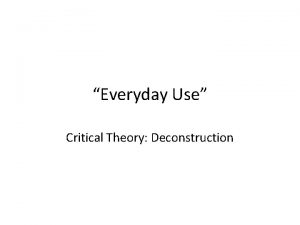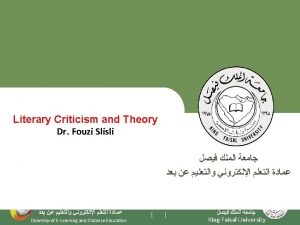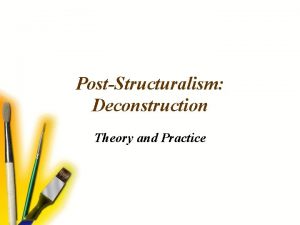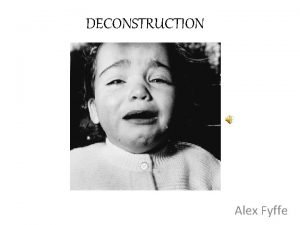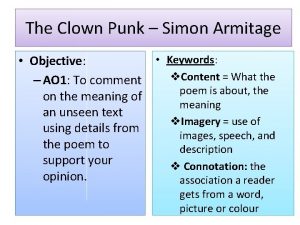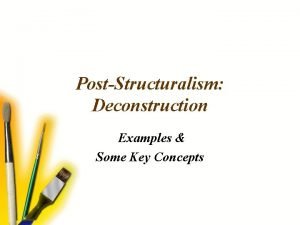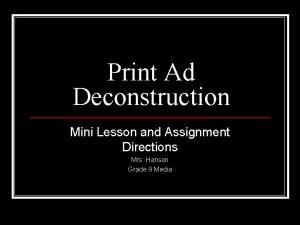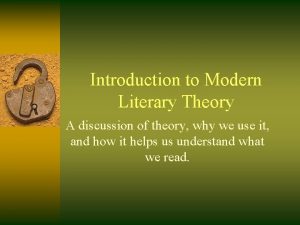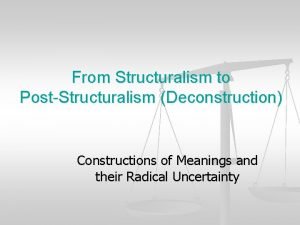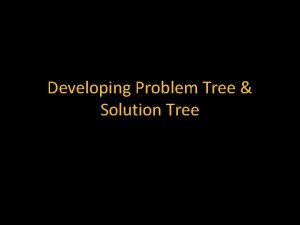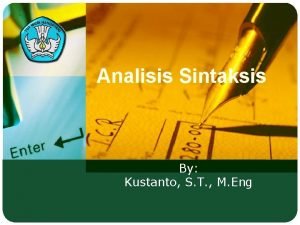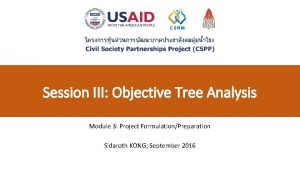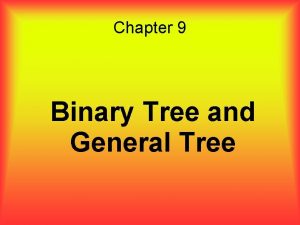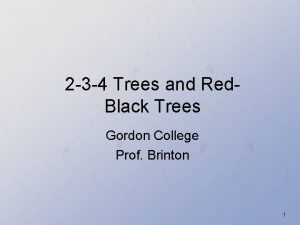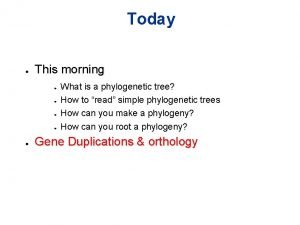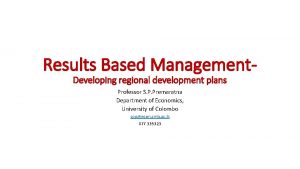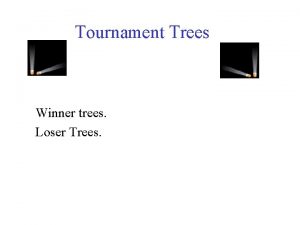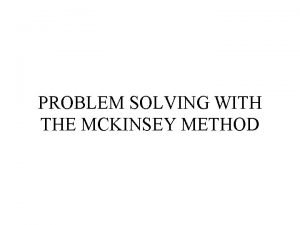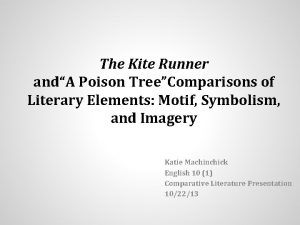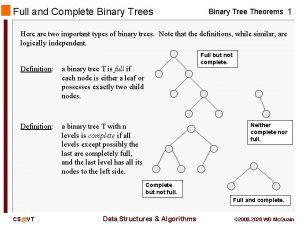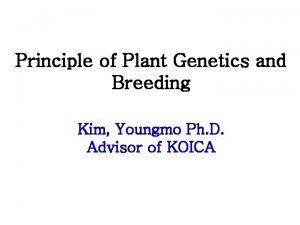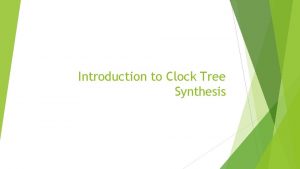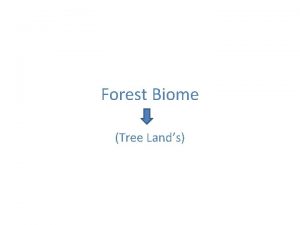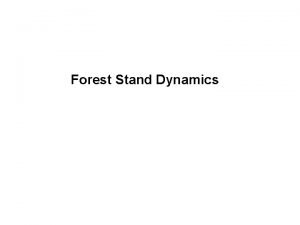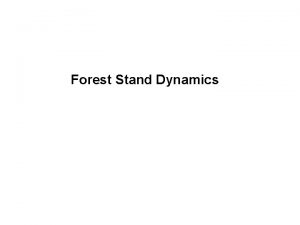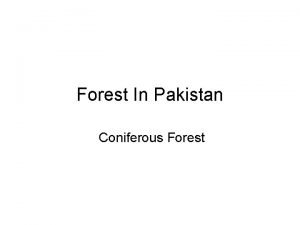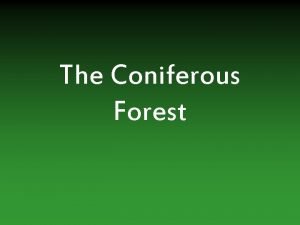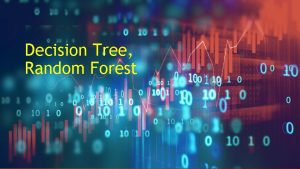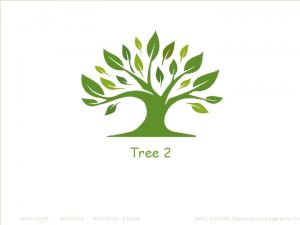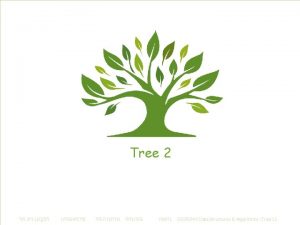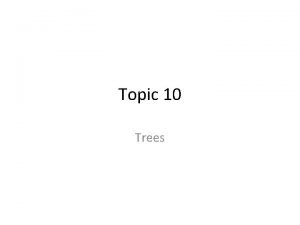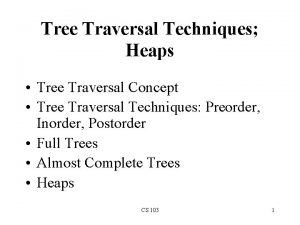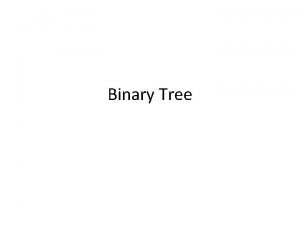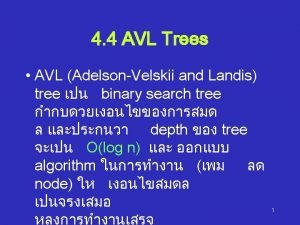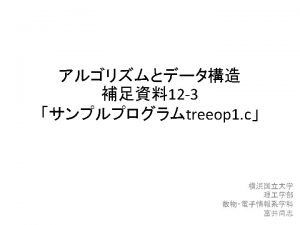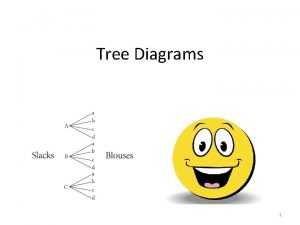Deconstruction From the tree to the forest Deconstruction


































- Slides: 34

Deconstruction From the tree to the forest

Deconstruction – 1960 s • Deconstruction is a cultural, political, and literary movement that originated alongside postmodernism, and is based largely (but not exclusively) on Jacques Derrida’s writings. The main point of deconstruction is that language and human knowledge in general are not fixed and absolute, but rather fluid and uncertain. • Product of tensions between West and East, sexual revolution, cultural and political resistance

The fluidity of a single utterance President Reagan says the Marines do not have to go to El Salvador. Note how the meaning of the sentence changes dramatically, depending on which word is emphasized

Language isn’t as stable and reliable as we generally assume it is. As we saw in earlier classes, structuralists and semioticians use the word sign to denote a basic element of communication, and they define sign by the following formula: sign = signifier + signified (sound, image, (concept to which gesture, etc. ) the signifier refers)


This cat is fat

• Am I comparing the cat to myself? To my cats? • To another cat? What other cat? • Am I surprised by the size of the cat? Am I saddened? Amused? • Do I wish to impart information about the cat? • Am I teaching you the literal meaning of the words cat and fat? • Am I being sarcastic?

• human utterances are rarely, if ever, as clear and simple as the structuralist formula signifier + signified seems to imply (Tyson)

• If we stopped at this point, we could rewrite the structuralist formula as sign = signifier + signified. . . + signified. That is, we could try to explain communication as a sliding accumulation of signifieds. But what does the term signified mean? If the signifier is “tree, ” then the signified must be the tree in our imagination that we can picture

• According to deconstruction, the word tree never reaches the point when it refers to one singular concept, a signified • Signifier + ? = sign • The signifier I utter refers to chains of signifiers in my mind and evokes chains of signifiers in the mind of the person who hears my utterance. And each signifier in those chains is itself constituted by another chain of signifiers, and so on. • How do we even communicate?

• for deconstruction, language does not consist of the union of signifiers and signifieds; it consists only of chains of signifiers • structuralism says that language is nonreferential because it doesn’t refer to things in the world but only to our concepts of things in the world • deconstruction takes that idea a big step further by claiming that language is nonreferential because it refers neither to things in the world nor to our concepts of things but only to the play of signifiers of which language itself consists • If structuralism divides the sign from the referent by bracketing it off, deconstruction articulates the division between the signifier and the signified. Langue is not treated as an enclosed system of signs but as site always already informed by play, which determines and opens the signifier-signified relation.

Jacques Derrida • Deconstruction is a political praxis, an attempt to dismantle the logic by which a particular system of thought and behind that a whole system of political structures and institutions maintain their force. • what we take to be meaning is really only the mental trace left behind by the play of signifiers. And that trace consists of the differences by which we define a word.

• Derrida argues that language has two important characteristics: (1) its play of signifiers continually defers, or postpones, meaning, and (2) the meaning it seems to have is the result of the differences by which we distinguish one signifier from another. He combines the French words for “to defer” and “to differ” to coin the word différance, which is his name for the only “meaning” language can have. But even while we use language, we can be aware that it doesn’t have the solidity and stability we have assumed it has, and we can therefore improvise with it, stretch it to fit new modes of thinking (an activity he calls bricolage).

"Il n’y a pas de hors-texte" • language mediates our experience of ourselves and the world • There is no outside to the outside of the text • This is a principal Derridean concept. The Text is an attempt to include its own outside; there is no outside of that (in the same manner, there is no escape from the metaphysical circle). Derrida tries to overturn the opposition between the inside/outside opposition (to overturn the representation of the text as an inner reality that defies the outside by reducing it). He suggests that the text is a space where the borders between writing and speech, private and public, reality and text, art and life, representation and being are already dissolved.

• for deconstruction, language is wholly ideological: it consists entirely of the numerous conflicting, dynamic ideologies— or systems of beliefs and values—operating at any given point in time in any given culture. For example, our use of the word slut for a woman who sleeps with many men and the word stud for a man who sleeps with many women reveals and perpetuates the cultural belief that sexual relations with multiple partners should be a source of shame for women and a source of pride for men.

Good/Evil West/East Binary oppositions Human/Animal What is the relationship between these binaries as you understand them?

• HIERARCHY • by finding the binary oppositions at work in a cultural production (such as a novel, a film, a conversation, a classroom, or a courtroom trial), and by identifying which member of the opposition is privileged, one can discover something about the ideology promoted by that production

Objective versus subjective objective : the source of knowledge, rational subjective : merely the source of opinion, emotional BINARIES OFTEN CONNOTE THIS UNDERLYING DIVISION

Human versus animal • In your own words, what is Derrida’s point? What question(s) does he raise? • Derrida reads De. Cartes, Levinas, Heidegger, Lacan to protest • Why is the animal the opposite of the human? • Speaking of the entire philosophical tradition, Derrida accuses it of having deliberately forgotten the animal, and along with it the very animality of human beings, of this life which crosses our path but which philosophy insists on covering up, excluding it from something that is supposed to be proper only to human beings • calls into question the entire construction, as fragile as it is vast, of Western rationality (which may be too massively reduced if we call it “metaphysics”), through which human beings arrogate to themselves a level of privilege within the entire creation. This distinguishes human beings from the multitude of other living creatures, which human beings do not wish to deal with fairly

• According to Western doctrine, humans are distinguished by their culture, their minds, their reasoning, and their thinking, nonhumans by the conceptual antithesis of each of these categories. It is not that humans do not have anything natural about them, that they do not have bodies, that they do not have capabilities to do as well as to think, that they do not have emotions; it is that in the axiological scheme of the four oppositions, these commonly conceived possessions are of inestimably lesser significance and value than their opposites. Indeed, they would not in any preeminent sense be characterized as the natural possessions of humans. Culture, mind, thinking, and reasoning are the natural possessions of humans, just as nature, body, doing, and emotion are the natural possessions of nonhumans. The same axiological scheme obtains in binary oppositions having to do with behavioral ascriptions. It is humans who, in virtue of their humanness, are capable of planning ahead, for example; it is they who devise strategies for the future and who do not live simply in the moment. In contrast, it is nonhumans who are present-oriented, who grab whatever is at hand (Sheets-Johnstone 1996)

Human versus animal “Even when that tradition defines the human as zoon logon echon or as rational animal, as an ‘‘animal’’ therefore, but one endowed with reason, it has always in fact opposed us to all the rest of animalkind, going so far as to erase all animality in us and, conversely, to define the animal, in an essentially negative way, as deprived of whatever is presumed to be ‘‘proper’’ to the human: ‘‘speech, reason, experience of death, mourning, culture, institutions, technics, clothing, lying, pretense of pretense [feinte de feinte], covering of tracks, gift, laughing, tears, respect, etc. ’’ And, Derrida emphasizes, ‘‘the most powerful philosophical tradition in which we live has refused the ‘animal’ all of that. ’’ 3 Philosophical ‘‘logocentrism, ’’ inseparable from a position of mastery, is in the first instance ‘‘a thesis regarding the animal, the animal deprived of the logos, deprived of the can-have-the-logos: this is thesis, position or presupposition maintained from Aristotle to Heidegger, from Descartes to Kant, Levinas and Lacan, ’’ he writes elsewhere. Moreover, the violence done to the animal begins, he says, with this pseudo-concept of ‘‘the animal, ’’ with the use of this word in the singular, as though all animals from the earthworm to the chimpanzee constituted a homogeneous set to which ‘‘(the hu)man’’ would be radically opposed. As a response to that first violence Derrida invents the word animot, which, when spoken, has the plural animaux, heard within the singular, recalling the extreme diversity of animals that ‘‘the animal’’ erases, and which, when written, makes it plain that this word [mot] ‘‘the animal’’ is precisely only a word. As a result, the different occurrences of this animot in his text function as so many alarm signals, wake-up calls designed to prevent the usage or unavoidability of the term the animal, in the singular, from soothing us into an all-too-ordinary and all-too-little-noticed dogmatic slumber” (Mallet 2008)

• Derrida’s suspicion was that the promotion, on the part of human beings, of the difference incarnated by human reason is founded upon an act of forgetting, of repression, even of originary violence, the denial of the animality of human beings, leading to a denial of their mortality. ll Derrida’s work is intended as a struggle against this violence, because it is literally equivalent to a “denaturing” of human beings—men need to extricate themselves from nature while giving the name “the animal” to presumably lesser beings-- “a name [men] have given themselves the right and the authority to give to the living other” (p. 23)

• Like us, animals feel, suffer, are born, die, and reproduce. They understand each other, and they make us understand what they have to say, and not just through their voices. And the language of the animal who is looking at me also says to me “Thou shalt not kill me, ” does it not? Centered upon themselves, human beings usually turn a deaf ear to this appeal. • “However one interprets it, whatever practical, technical, scientific, legal, ethical, or political consequence one draws from it, no one can today deny this event – that is, the unprecedented proportions of this subjection of the animal. Such a subjection, whose history we are attempting to interpret, can be called violence in the most morally neutral sense of the term and even includes the interventionist violence that is practiced, as in some very minor and in no way dominant cases, let us never forget, in the service of or for the protection of the animal, but most often the human animal. Neither can one seriously deny the disavowal that this involves” (Derrida)

Derrida will not participate in the same disavowal and is not afraid to use the words that others may have shied away from--holocaust, genocide--to describe in detail the kinds of violence done to animals through industrial farming or biological experimentation and manipulation, all for the “putative human well-being of man” (p. 25). As Matthew Callarco explains, Derrida’s work is aimed at undercutting the kinds of humanist hierarchies that oppose such analogies as scandalous simply because they compare human and nonhuman life In tracking and deconstructing the subject from Descartes through Lacan, he attempts to uncover the fraudulent grounds on which the human has been defined in opposition to the animal and thereby claimed superiority over it. If thinking is, as Descartes posits, the essence of what or who I am as human, that is the cause of my being as human, Derrida asks how we know that thinking is so different from sniffing or scenting and “why this zone of sensibility is so neglected or reduced to a secondary position in philosophy and the arts? ” (p. 55).

• Lacan: “man is an animal but a speaking one, and he is less a beast of prey than a beast that is prey to language. There is no desire, and thus no unconscious, except for the human” (Derrida) • Lacan: also refuses the animal language, recognizing in its case only what he calls a ‘‘code, ’’ the ‘‘fixity of coding’’ or a ‘‘system of signalling’’ (Derrida) • Lacan: the Other as the one from whom “the subject receives even the message that he emits’’ i. e. my response to my cat is dictated by the cat’s reaction • Reaction versus response

Derrida responds • “Entry into the human order of the law presupposes this passive finitude, this infirmity, this lack from which the animal does not suffer. The animal does not know evil, lying, deceit. What it lacks is precisely the lack by virtue of which the human becomes subject” (130) • Human lack: knowledge of finitude, of death • Because the animal lacks that knowledge, lacks this lack, humans name it animal

• For Derrida, Levinas (philosopher who extensively discussed the Other) has put “the animal outside of the ethical circuit”(106) • Could it be that the “sacrificial war” against the animal, ” which Derrida says is as old as Genesis (p. 101), is also linked to the war against “the feminine”--a term that has been similarly essentialized with often violent effects? • What is the animal after all? • Animot: By replacing “animal” with “animot, ” Derrida hopes to remind the reader of the multiplicity of animal beings, their complicated relationship to human beings, as well as the ways in which animal multiplicity radically complicates traditional human-animal distinctions. • “Neither a species nor a gender nor an individual, it is an irreducible living multiplicity of mortals, and rather than a double clone or a portmanteau word, a sort of monstrous hybrid, a chimera waiting to be put to death by its Bellerophon” (Derrida 41)

Why is that important for literature? (1) language is dynamic, ambiguous, and unstable, continually disseminating possible meanings; (2) existence has no center, no stable meaning, no fixed ground; and (3) human beings are fragmented battlefields for competing ideologies whose only “identities” are the ones we invent and choose to believe.

Why would we apply deconstructive criticism? (1) to reveal the text’s undecidability and/or (2) to reveal the complex operations of the ideologies of which the text is constructed. To reveal a text’s undecidability is to show that the “meaning” of the text is really an indefinite, undecidable, plural, conflicting array of possible meanings and that the text, therefore, has no meaning, in the traditional sense of the word, at all. This goal can be accomplished, in brief, by the following procedure: (1) note all the various interpretations—of characters, events, images, and so on—the text seems to offer; (2) show the ways in which these interpretations conflict with one another; (3) show these conflicts produce still more interpretations, which produce still more conflicts, which produce still more interpretations; and (4) use steps 1, 2, and 3 to argue for the text’s undecidability.

Example

The following two questions summarize the two deconstructive approaches discussed in this class • How can we use the various conflicting interpretations a text produces (the “play of meanings”) or find the various ways in which the text doesn’t answer the questions it seems to answer, to demonstrate the instability of language and the undecidability of meaning? (Remember that deconstruction uses the word undecidability in a special way). • What ideology does the text seem to promote—what is its main theme — and how does conflicting evidence in the text show the limitations of that ideology? We can usually discover a text’s overt ideological project by finding the binary opposition(s) that structure the text’s main theme(s).

Example

What are the binaries? • Black and white • Man and woman • Sane and insane • Innocence and experience • From a proto-feminist reading to a reading that affirms the superiority of the white woman, of whiteness, and of the Empire project

Your turn • Pick a text that we have studied and note down the binaries that the text relies on. • Are there conflicting interpretations? • What are the limits of the text’s ideological structure?
 Deconstructionism
Deconstructionism Post structuralism in literature
Post structuralism in literature Deconstruction theory assignment
Deconstruction theory assignment Alex fyffe
Alex fyffe The clown punk poem
The clown punk poem Deconstruction examples
Deconstruction examples Print ad assignment
Print ad assignment Advantages and disadvantages of biography
Advantages and disadvantages of biography Logocentrism
Logocentrism Dynamic deconstruction
Dynamic deconstruction Ad deconstruction examples
Ad deconstruction examples Highest point of a wave
Highest point of a wave Tree forest
Tree forest The bw-tree: a b-tree for new hardware platforms
The bw-tree: a b-tree for new hardware platforms Problem tree
Problem tree Pohon sintaks adalah
Pohon sintaks adalah Loser tree algorithm
Loser tree algorithm Example of a problem tree
Example of a problem tree Difference between general tree and binary tree
Difference between general tree and binary tree Ticks and dogs symbiotic relationship
Ticks and dogs symbiotic relationship Convert 2-3-4 tree to red black
Convert 2-3-4 tree to red black Species tree
Species tree Problem tree and objective tree
Problem tree and objective tree Winner tree
Winner tree 7 steps problem solving mckinsey
7 steps problem solving mckinsey The kite runner motifs
The kite runner motifs Full binary tree and complete binary tree
Full binary tree and complete binary tree Foragry
Foragry H-tree clock tree synthesis
H-tree clock tree synthesis Definition of threaded binary tree
Definition of threaded binary tree Công thức tính độ biến thiên đông lượng
Công thức tính độ biến thiên đông lượng Tỉ lệ cơ thể trẻ em
Tỉ lệ cơ thể trẻ em Thế nào là mạng điện lắp đặt kiểu nổi
Thế nào là mạng điện lắp đặt kiểu nổi Lời thề hippocrates
Lời thề hippocrates Vẽ hình chiếu đứng bằng cạnh của vật thể
Vẽ hình chiếu đứng bằng cạnh của vật thể
